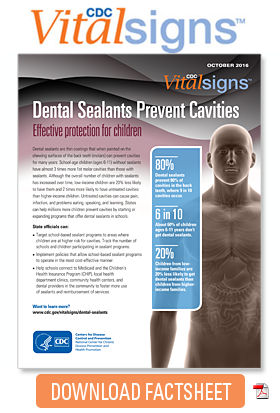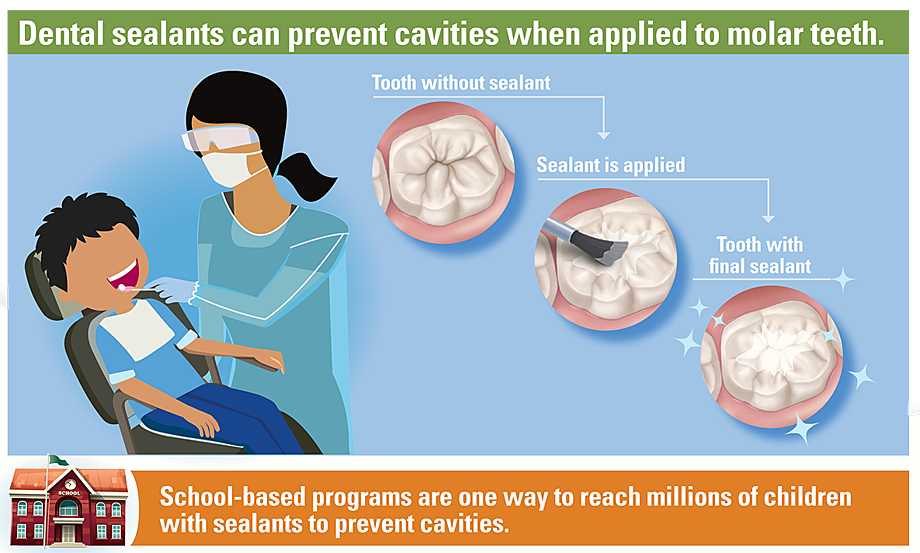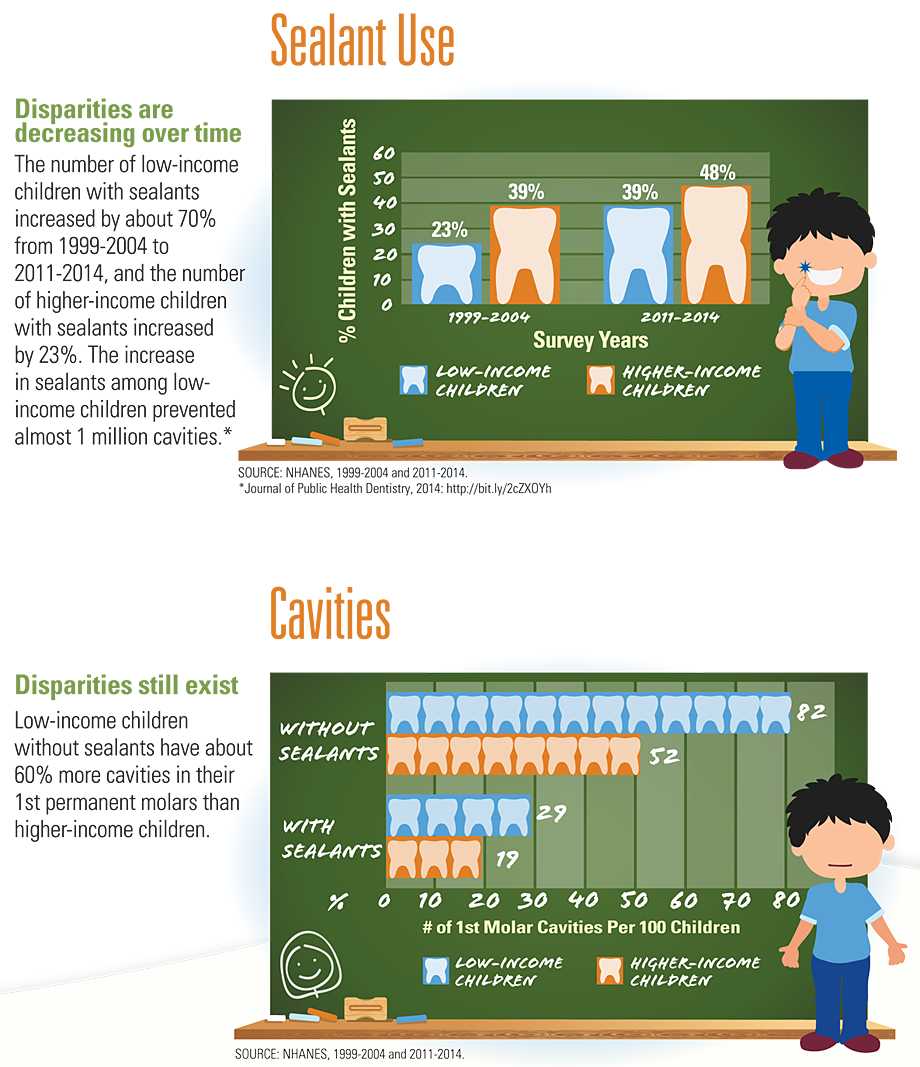Dental Sealants Prevent Cavities
Effective protection for children
Overview
Dental sealants are thin coatings that when painted on the chewing surfaces of the back teeth (molars) can prevent cavities for many years. School-age children (ages 6-11) without sealants have almost 3 times more 1st molar cavities than those with sealants. Although the overall number of children with sealants has increased over time, low-income children are 20% less likely to have them and 2 times more likely to have untreated cavities than higher-income children. Untreated cavities can cause pain, infection, and problems eating, speaking, and learning. States can help millions more children prevent cavities by starting or expanding programs that offer dental sealants in schools.
State officials can:
- Target school-based sealant programs to areas where children are at higher risk for cavities. Track the number of schools and children participating in sealant programs.
- Implement policies that allow school-based sealant programs to operate in the most cost-effective manner.
- Help schools connect to Medicaid and the Children’s Health Insurance Program (CHIP), local health department clinics, community health centers, and dental providers in the community to foster more use of sealants and reimbursement of services.

Problem
About 7 million low-income children need sealants.
What are sealants?
- Sealants are thin coatings painted on teeth to protect them from cavities. They flow into the deep grooves of teeth and harden immediately so a child is able to chew right away.
- Sealants prevent the most cavities when applied soon after permanent molars come into the mouth (around age 6 for 1st molars and age 12 for 2nd molars).
- Sealants can be applied by a dentist, dental hygienist, or other qualified dental professional, depending on state law and regulations. This can be done in dental offices or using portable dental equipment in community settings like a school.
Why use sealants?
- Sealants are a quick, easy, and painless way to prevent most of the cavities children get in the permanent back teeth, where 9 in 10 cavities occur.
- Once applied, sealants protect against 80% of cavities for 2 years and continue to protect against 50% of cavities for up to 4 years.
- Sealants can eliminate the need for expensive and invasive treatments like dental fillings or crowns.
- Applying sealants in schools for about 7 million low-income children who don’t have them could save up to $300 million in dental treatment costs.
Infographics
What Can Be Done
The Federal government is
- Classifying pediatric dental services as an essential health benefit to be covered by dental insurance as part of the Affordable Care Act.
- Matching state costs for applying dental sealants for all children enrolled in Medicaid/CHIP and tracking program performance.
- Encouraging community health centers with dental programs to start or expand school-based sealant programs to help more low-income children.
- Helping fund states to increase the number of dental sealant programs.
- Providing incentives for dentists to practice in under-served areas to increase access to dental services.
State officials can
- Target school-based sealant programs to the areas of greatest need. Track the number of schools and children participating in sealant programs.
- Implement policies that deliver school-based sealant programs in the most cost-effective manner.
- Help schools connect to Medicaid and CHIP, local health department clinics, community health centers, and dental providers in the community to foster more use of sealants and reimbursement of services.
Dental care providers can
- Apply sealants to children at highest risk of cavities, including those covered by Medicaid/CHIP. Donate time and resources to a school-based dental sealant program.
- Learn about school-based dental sealant programs and their effectiveness.
- Accept children into their practice who are identified as needing more services when they receive sealants in schools.
School administrators can
- Work with the local or state public health programs and local dental providers to start school-based sealant programs.
- Support having sealant programs in schools and promote its benefits to teachers, staff, and parents. Help children enroll in sealant programs by putting information for parents in registration packets in the beginning of the school year.
- Encourage schools to develop relationships with local dental offices and community dental clinics to help children get dental care.
Parents can
- Ask your child’s dentist to apply sealants when appropriate.
- Sign your child up to participate in a school-based sealant program. If your school does not have sealant program, ask them to start one.
- Find a dentist if your child needs one. Use the Insure Kids Now Dentist Locator: http://bit.ly/2dwnU5E
Issue Details
Related Pages
- Vital Signs Issue details: Morbidity and Mortality Weekly Report (MMWR)
- Vital Signs – Dental Sealants [PODCAST – 1:15 minutes]
- Vital Signs – Dental Sealants [PSA – 0:60 seconds]
- CDC Oral Health Website
- CDC School-Based Dental Sealant Programs
- CDC Dental Sealant FAQs
- CDC SEALS Software
- CDC State Strategies: Preventing Tooth Decay
- CDC Oral Health Data
Other Sites
- MedlinePlus – Child Dental Health
- MedlinePlus – Tooth Decay
- American Dental Association – Evidence-based clinical practice guideline for the use of pit-and-fissure sealants
- InsureKidsNow.gov: Find a Dentist
- Healthy People 2020
- The Community Guide: School-Based Dental Sealant Programs
- Association of State & Territorial Dental Directors – Best Practice Approach Report- School-based Dental Sealant Programs
- National Maternal & Child Oral Health – Seal America
- Children’s Dental Health Project – Dental Sealants: Proven to Prevent Tooth Decay
- Pew Charitable Trusts – States Stalled on Dental Sealant Programs
Scientific Articles
- Journal of the American Dental Association – Preventing Dental Caries Through School-Based Sealant Programs
- Journal of Dental Research: The Effectiveness of Sealants in Managing Caries Lesions
- Journal of the American Dental Association: The Effect of Dental Sealants on Bacteria Levels in Caries Lesions: A Review of the Evidence
- Journal of the American Dental Association: Exploring Four-Handed Delivery and Retention of Resin-Based Sealants
- Journal of the American Dental Association: A Comparison of the Effects of Toothbrushing and Handpiece Prophylaxis on Retention of Sealants
- Journal of the American Dental Association: Caries Risk in Formerly Sealed Teeth
Science Behind the Issue
- Page last reviewed: October 18, 2016
- Page last updated: October 18, 2016
- Content source:
Error processing SSI file


 ShareCompartir
ShareCompartir


